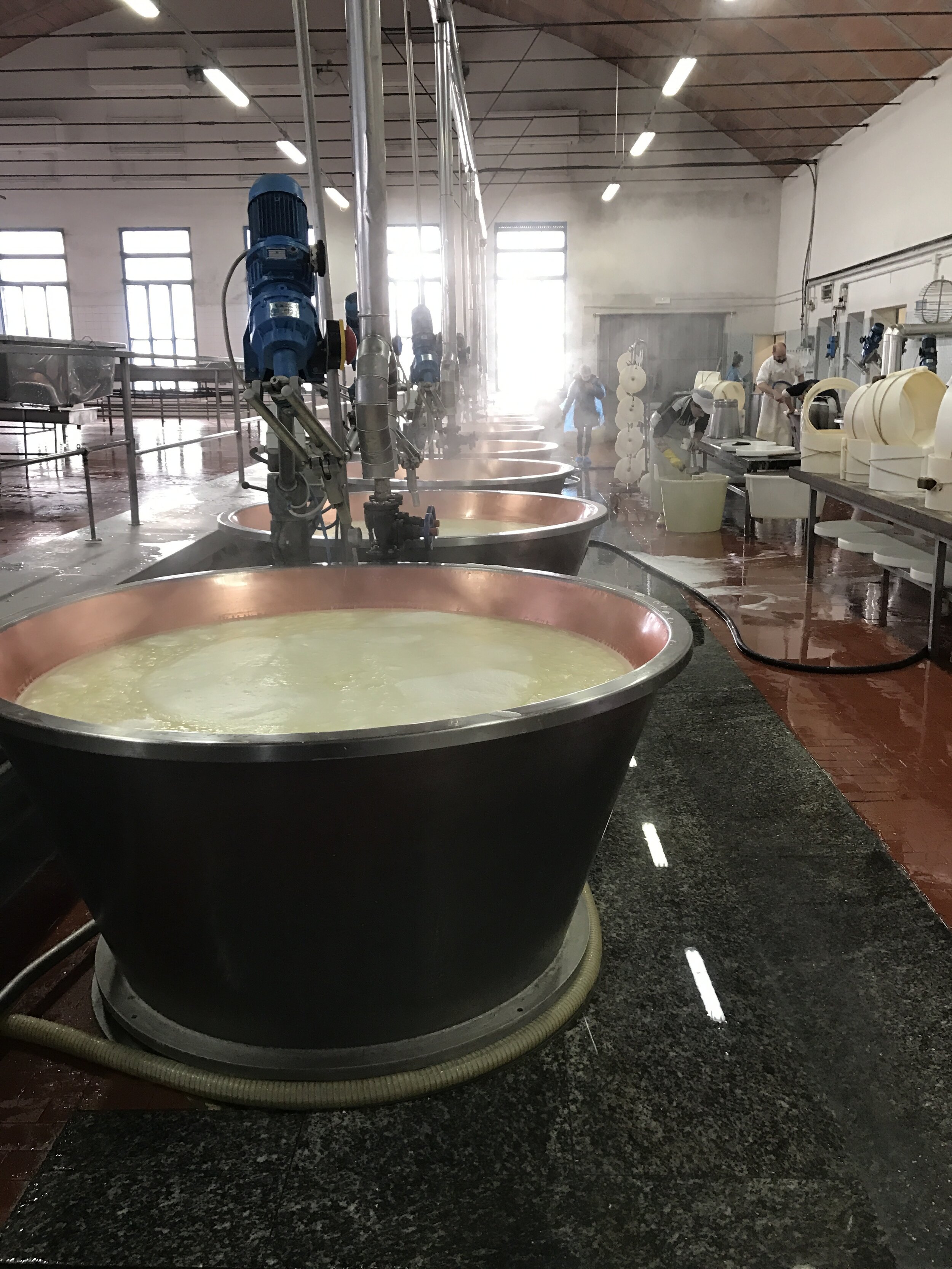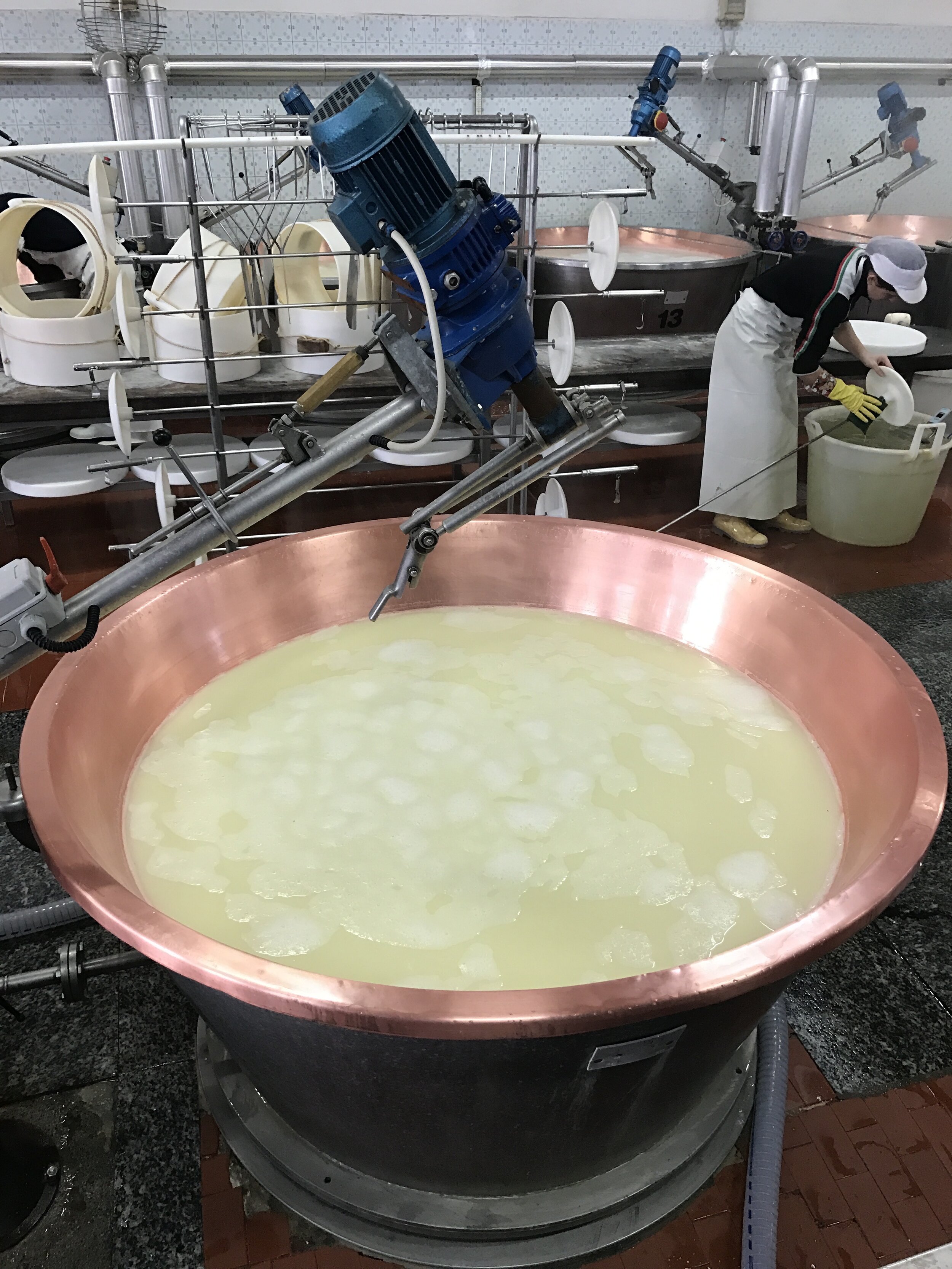The Big Cheese
“If you observe the texture of Parmigiano under a very strong magnifying glass, it is revealed to be not just an unchanging mass of granules linked together into cheese but a panorama. It is an aerial photograph of Emilia taken from a height similar to that of the Eternal Father.”
— Giovannino Guareschi (1908-1968), Italian writer and journalist
We’ve all heard of the infamous Parmesan cheese, but what makes Parmigiano Reggiano in particular so special? In the heart of Emilia-Romagna, Italy lies the historic town of Parma. Nestled between fertile fields of green farmland and grazing cows, this region is the only place in the world where this cheese (aka ‘the king of all cheeses’) can officially be made.
The art of cheese-making in Italy is especially important — families pass down the skill through generations and are closely monitored by, believe it or not, ‘The Consortium of Cheese’. The organization was established in the early 1900s in an effort to preserve the authenticity, quality, and tradition of cheese-making in Italy and on the world’s stage. So what does this mean? Cheesemakers here have to carefully follow a long list of rules — from using milk only from cows raised within a geographical region, following a detailed production process, achieving a specific aroma, taste, and texture, and aging for a certain amount of time… only name a few. Let’s just say there’s no room to add your own personal flair into this, and that’s exactly the point. Some may say this is ridiculous, but I can get behind it. There’s a certain reputation that Italians want to achieve, the idea that nobody else in the world can make this stuff, and it’s for sure an art form worth preserving. So if there’s one thing, they take cheese-making here very seriously and raise this standard to a whole new level.
Through the rolling hills of this region’s Italian countryside, cows graze the surrounding green where their diet solely consists of grass and hay. This coupled with the region’s surrounding environment supplies the milk with a unique microbial flora that is native to this area and helps create a favorable environment for lactic fermentation to take place. With this, the quality and flavor profile of the final cheese all starts with the milk and is further transformed with the touch of an experienced cheesemaker.
Parmigiano is made of only three ingredients — milk, salt, and cow’s rennet — but undergoes quite a labor-intensive transformation. In the early morning, cheesemakers are hard at work, tending to jacuzzi-sized copper kettles filled with fresh milk, transforming into soft cheese curds right before your eyes. Gusts of steam rise from the top of these kettles and fill the morning air with milky vapors. And all the while, cheesemakers are dressed head-to-toe in all protective gear in an effort to not be covered in sour whey. Before becoming cheese, the milk must undergo a series of steps from heat transformation, curd formation, cutting, lots of TLC, and some heavy lifting. All in an effort to neatly pack this fresh cheese into a mold that will hold its shape until it sets while doubling as a special stamp that indents its distinctive dotted inscriptions around the whole circumference. Most importantly, it marks the production of origin and date, adding to its unique identity and traceability.
I won’t bore you with the full and highly detailed production process, but it should be noted that the amount of care integrated into each and every step by these talented cheesemakers is part of the reason why this cheese has maintained its reputation for hundreds of years around the world.
What also makes this cheese particularly special is the element of time. Although Parmigiano can be made in one singular day, the aging process can continue on for years. First spending a few days in a highly salted solution for flavor and preservation, followed by a maturation period of at least one year — the longest of all regulated Italian cheeses — and up to a whopping 40 months or more. Not only does this year-long maturation signify the cheese’s identity as ‘Parmigiano Reggiano’, experts from the Consortium must confirm its quality based off the sound of a hammer tap and a highly trained ear. This coupled with the appropriate aging time, now these special cheeses are ready to be devoured, grated over your favorite pasta dish, or best consumed in chunks drizzled with aged balsamic vinegar. So the next time you take a trip to the grocery store, take a look at your local cheese section to see if you can spot this cheese and taste the difference.
The Taste of Parmigiano Reggiano
I have to admit, all this talk about cheese, is making me hungry! And I’m sure you’re wondering what does this cheese taste like in the end?
This cheese is a sensory experience that is a complex blend of sweet, salty, nutty, and umami characteristics. The beauty of this cheese is that as it ages, the flavors intensify, the color darkens into an amber yellow, and most interestingly develops tiny white crystals that add to its complex flavor and crumbly texture.
History of Cheese & Cultural Significance in Italy
Some of the earliest cheese-making in Italy dates back 2,000 years and today, over 600 different kinds of cheese are made throughout the country. During the Middle Ages, cheesemaking found its humble beginnings when monks discovered a way to preserve the milk and transform it into a product that was nutritious, affordable, and most importantly, long-lasting. For many Italians who could not afford to serve meat on the table regularly, this solution was a great alternative as the virtually endless supply of milk could provide food in the form of cheese during times of ration while keeping their cows alive. From then on, the advancement and refinement of cheese-making over the years from its raw form to cooked curds led to a product that could be matured and be preserved for much longer. With this, cheese became a staple in the Italian diet not only for survival, but has transformed into a tradition and art form that gives character to each and every region it’s made in.
*All photography in this article by Chrissy Chen.
Sources:
Local visit to Caseificio Sociale Bassa Parmense in Sorbolo, Province of Parma, Italy.
“The Official Website of the Consortium.” Parmigiano Reggiano, www.parmigianoreggiano.com/.












